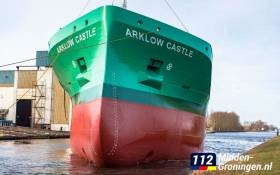Displaying items by tag: Newbuild Arklow Castle
Launch of Third ‘C’ Class Cargoship Arklow Castle Revives Old Name
#CastleLaunch- Arklow Castle was launched in the Netherlands yesterday to form the third ‘C’ class newbuild of a 10-ship order from the Co. Wicklow based operator, writes Jehan Ashmore.
The 5,054dwt cargoship Arklow Castle (yard No. 426) slid into the canal at the Ferus Smit shipyard in Westerbroek.
Arklow Castle has a maximized single-hold volume of 220.000cft and a carrying capacity over 5000 deadweight tons and still falls under the 3,000 gross tons limit. The newbuild's hull has an 1A iceclass notation. Propullsion is from a 1740 kW MaK engine with a single ducted propeller.
ASL transport cargoes among them: bulk grain and dangerous bulk cargoes, steel rails, minerals, generals, offshore and landline pipes and provision to carry containers.
Arklow Castle follows sisters ‘Cape’ launched last October and leadship ‘Cadet’. Both these 2,999grt newbuilds have been given new names whereas Arklow Castle revives a predecessor that operated a rare ‘container' only liner-service for ASL until around 2006.
This former Arklow Castle ran a liner-service between Avonmouth (Bristol) to Bilbao link with calls to Greenock and Dublin on the outward voyage.
According to the ASL fleet list, a ‘W’ class bulker, Arklow Wave is no longer included. This leaves only Arklow Wind as the final of a trio of South Korean built ships dating from the early 2000’s left in service.
As reported on Afloat the 14,000dwt Arklow Willow was sold last year to Canadian interests, McKeil Marine, Hamilton which saw the ship make a delivery voyage to Lake Ontario.
























































